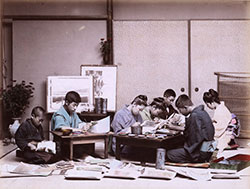Condition guide
Introduction
 The following guidelines are intended to provide a concise method of describing the condition of photographic prints for curators, collectors, auction specialists, dealers and appraisers. They may be particularly useful in cases where the original photograph may not be readily examined.
The following guidelines are intended to provide a concise method of describing the condition of photographic prints for curators, collectors, auction specialists, dealers and appraisers. They may be particularly useful in cases where the original photograph may not be readily examined.
Aside from the causes of deterioration that may afflict any art on paper, there are particular problems affecting photographs, mainly those printed on light-sensitive silver-based photographic papers. These causes include improper fixing or insufficient washing of prints; use of acidic mount card and/or harmful adhesives; exposure to light, pollution and/or extremes of temperature or humidity.
This guide is not meant to be a substitute for seeing the actual print, or to preclude the use of more complete condition reports. It is intended, however, to provide, using a relatively brief description, a consistent system that gives a reasonable idea of what to expect in terms of print condition. The adoption of such a system should result in a more reliable measure for judging the condition of catalogued prints. Such a scheme may help a curator, for example, to decide by a glance at an archived record if a print should be considered for possible exhibition, publication or restoration. It may also enable a potential purchaser to have a better idea of the condition of a print shown in a catalogue or on the internet.
Tonality
A numerical scale of 1 to 10 describes the tonality or richness of the print.
The richness of the tones in a print, relative to what one might expect from the particular process in use, is often of the foremost concern to curators and collectors. This is particularly so for 19th century photographs, only a small percentage of which now retain their original depth or brilliance of tone.
Common reasons for a print achieving a less high rating for tonality are:
- Overall fading
- Yellowing (usually to highlights)
- Printing which was less than excellent in the first instance. The print may be rather 'flat' or have poor contrast.
Edge fading is covered in the following section under deterioration and should be described as specified, independently of the overall tonality. A rating of 10/10, however, is reserved only for excellent print quality with no visible yellowing or fading of any kind.
View examples of photographs with tonalities of 5/10, 6/10, 7/10, 8/10, 9/10, or 10/10.
Deterioration and Restoration to Photograph
This category is for defects to the paper support of the photographic image, i.e. the paper on which the photograph has been printed (not the mount). The most common types of deterioration include:
- Fading- 'edge' or 'local' (overall fading is implicitly covered in tonality)
- Yellowing (implicit in tonality rating but should be described if this is a notable fault)
- Foxing
- General or local staining
- Creasing (encompasses bumps and wrinkles)
- Tears
- Losses (part of print is missing)
- Surface dirt
- Abrasions (i.e. striations, scratches)
- Surface loss (loss of emulsion or paper from surface)
- Negative loss ( emulsion loss from negative which is visible in the print)
- Sulphurisation (sometimes called oxidation)
Others should be specified, depending on the problem: e.g. brittleness, skinning (loss of paper support on verso); dirt or air bubbles between print and mount; writing, rubber stamps or indentations to verso which show recto; paper adhering to surface; crude varnishing, paint, writing or excessive retouching on surface.
A verbal rating describes the extent of any damage in ascending order of seriousness: Minor; Some; Major
Restoration, where applicable, may be described in a similar way. A repaired tear is still a tear and must be indicated as such under deterioration, e.g. Some tears, repaired.
There are some types of damage, particularly to 19th century albumen prints, that are so typical that it is unnecessary to mention them, such as minimal surface abrasions and/or minimal creasing. A very small amount of surface wear is discernable on most albumen prints and should be expected.
For consistency, it is useful to list any condition problems in the same order each time.
Example: Samuel Bourne. The Manirung Pass. Albumen print, c. 1860s. Tonality - 8/10, minor edge fading, minor tears (repaired), some abrasions.
Ken Jacobson, Photography Dealer & Historian
Jane McAusland, Paper Conservator
We would like to thank the many people in the field who offered constructive comments while we were working on this Condition Guide but particularly to Lindsey Stewart for her very significant input.
